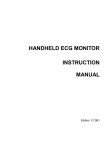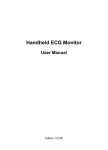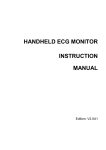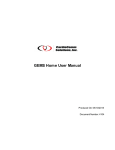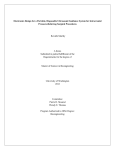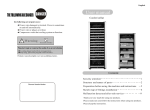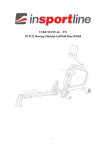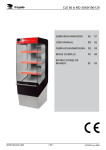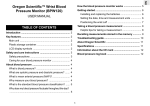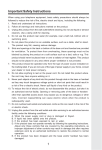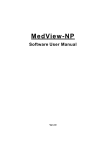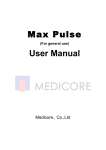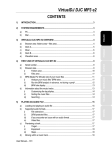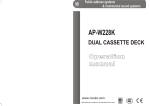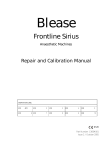Download Untitled - The HeartCheck
Transcript
VER1.0B1 HeartCheck HANDHELD ECG MONITOR Copyright This document is intended to be used solely for the use of the HeartCheck© ECG monitor. No part of this work may be copied or disseminated without prior written approval from the distributor. All information contained in this publication is believed to be correct at the time of publishing. The distributor shall not be liable for errors contained herein nor for incidental or consequential damages in connection with the furnishing, performance, or use of this material. The information this publication refers to is protected by copyrights or patents and does not convey any license under the patent rights of our company, nor the rights of others. We do not assume any liability arising out of any infringements of patents or other rights of third parties. Contents of this manual are subject to changes without prior notice. This item is compliant with Medical Device Directive 93/94/EEC of 14 June 1993, a directive of the European Economic Community. All rights reserved. Issue date: 20 July 2010 -1- VER1.0B1 HeartCheck HANDHELD ECG MONITOR Notes on Safety This device monitors and records ECG waveforms, it is not intended for medical diagnosis. Please refer any recordings to a qualified physician for medical interpretation. This device is not a substitute for seeking medical attention. If you believe you are experiencing any adverse medical event, you are to seek medical attention immediately. The recordings should be used as a reference for analyzing cardiac rhythm by doctors only. Always consult your doctor. Medical conditions can change suddenly. If you notice any change in your condition, consult your doctor, regardless of the measurement results. Warnings! Not intended for use on individuals with a cardiac pacemaker. Not intended for use with an implanted defibrillator. Do not use in the presence of flammable anesthetics, drugs or pressurized oxygen (such as in a hyperbaric chamber, ultraviolet sterilizer or oxygen tent). Do not use on individuals with significant resting tremors. Do not use on individuals with dermatological conditions. Intended for adult user only. Do not use batteries of a type other than that specified in this manual. Do not take measurements where the device will be exposed to strong electromagnetic forces. Caution! Do not expose the device to static electricity. Always disperse any static electricity from your body before handling the device. Do not take measurements in a moving vehicle. Do not use a cellular phone near the device. Do not disassemble, repair, or modify the device. Do not insert batteries with their polarities reversed. The chest electrode will be impeded by excessive body hair, remove hair at the electrode contact point. -2- VER1.0B1 HeartCheck HANDHELD ECG MONITOR General Avoid extremes in temperature and humidity. Do not use this device in locations subject to high or low temperatures or humidity. Use at a temperature within 5°C to 40 °C and below 80% RH. Do not sterilize this device in an autoclave or gas sterilizer (EOG, formaldehyde, high density ozone etc.). Do not wash this device with water. Do not store the device in the following ambient conditions. - Locations exposed to direct sunlight. - Locations subject to high temperatures and high humidity. - Wet or damp locations where water may get on the device. - Dusty locations. - Near fires or open flames. - Locations exposed to strong vibration. - Locations exposed to strong electromagnetic fields. Dispose of the device and its accessories according to applicable local regulations. -3- VER1.0B1 HeartCheck HANDHELD ECG MONITOR Contents 1. General Description..................................................................................................... - 5 - 2. Battery Installation....................................................................................................... - 7 - 3. Setting Date and Time................................................................................................. - 8 - 4. Taking a Measurement................................................................................................ - 9 - 5. Displaying an ECG..................................................................................................... - 19 - 6. System Settings ......................................................................................................... - 21 - 7. Data Management ...................................................................................................... - 22 - 8. Version .......................................................................................................................... - 23 - 9. Data Transmission ..................................................................................................... - 23 - 10. Trouble Shooting........................................................................................................ - 23 11. Key Symbols................................................................................................................ - 24 12. Technical Data............................................................................................................. - 25 13. Maintenance and Storage ........................................................................................ - 26 14. General information about the Heart and ECG Measurements ..................... - 27 Appendix ............................................................................................................................... - 29 - -4- VER1.0B1 HeartCheck HANDHELD ECG MONITOR 1. General Description 1.1 Know Your Device Picture 1-1 Description of Picture 1-1: ① POWER button: Power on or off the device. ② Right Metal Electrodes: Hold these two with right index finger when taking a measurement. ③ START button: The shortcut key for ECG measurement. ④ OK button: Press this button to confirm the selection or set date and time when in the Date and Time Setting Mode. ⑤ Button: Press this button to move the cursor to your desired menu or change the number, or move the wave form to the left. ⑥ Button:Press this button to move the cursor to your desired menu or change the number, or move the wave form to the right. ⑦ MENU button: Return to the previous menu by pressing this button. ⑧ Left Metal Electrodes: Place this against the center of left palm or chest when taking a measurement. ⑨ ECG cable socket: When taking a measurement by ECG cable, connect the ECG cable with this port. -5- VER1.0B1 HeartCheck HANDHELD ECG MONITOR ⑩ USB interface: Transmit data to the PC through this interface. 1.2 Product Features Small, portable and easy to use. Choice of two measuring modes. USB data transmission. Fast measurement in just 30 seconds. Up to 200, 30 seconds ECG Strips recorded. Measurement of one channel ECG anytime, anywhere you like. Display of ECG waveform, heart rate, ECG quality result and battery status on the backlit LCD screen. Auto power-off. Two AAA batteries. PC Software provided to review recordings. 1.3 Intended Use The MD100 ECG monitor is a handheld device intended for use in non-invasively recording and displaying of ECG waveforms for self recording of adults in daily life under physician direction to provide the physician with relevant data on the heart condition of their patient. The MD100 is a patient triggered event recorder which makes available to patients the ability to manually record transient cardiac events. The MD100 is suitable for patient and professional use. The MD100 ECG monitor allows the recorded ECG data to be saved to the device memory and to later display the ECG data on a computer. An ECG report can be printed from the computer. -6- VER1.0B1 1.4 HeartCheck HANDHELD ECG MONITOR Display The device screen is used to display the ECG waveform, a confirmation of the ECG quality, other parameters, such as time & date, battery status and the status of data storage in memory. Menu interfaces -7- Picture 1-2 “ Measurement”: Picture1- 3 Enter this menu to select the measurement mode and take a measurement. “ GRAPH Menu”: Enter this menu to review, delete, and lock the detected ECG “ SET Menu”: Enter this menu to set the Date & Time, Brightness, Beep Tone waveform and ECG quality result. On/Off, Automatic Power-off, Assign ECG ID Number and set Wave Scale. “ “ Data Management”: Enter this menu to delete data. Version”: Enter this menu to review the device’s information. 2. Battery Installation 2.1 Open the battery cover on the back panel of the device. 2.2 Insert two AAA batteries as indicated by the polarity sign (refer to Picture 2-1). Picture 2-1 2.3 Replace the battery cover on the back panel of the device. Ensure the polarity of the batteries is correct, otherwise the device will not function correctly. Battery life and replacement When the “Battery power is low please replace with fresh new batteries” message appears, replace batteries with new ones. Always turn off the device before replacing the batteries. Dispose of the used batteries according to the applicable local regulations. VER1.0B1 HeartCheck HANDHELD ECG MONITOR Battery life Two new AAA batteries will last for approximate 400 measurements. The batteries enclosed in the package are used for demonstration purposes. It is possible that these batteries will not last for 400 measurements. The battery life can be confirmed in the upper right of the LCD display. Full power low power When the sign ” no power ” appears, it means the Battery power is low please replace with fresh new batteries battery power is not sufficient, and the device will display the information as in picture 2-2. We suggest users replace the batteries with Picture 2-2 Low power new ones. CAUTION! Do not use batteries not specified for this device. Do not insert the batteries with the polarities in the wrong direction. Do not dispose of batteries in fire. If you come into contact with battery fluid, seek immediate medical attention. Remove batteries from this device during periods of non use. Disposal of the batteries should comply with local laws and regulations. 3. Setting Date and Time Always set the date and time before using the device for the first time. Routinely check whether the date and time are correct before using the device and reset if necessary. The date and time are important indicators when a measurement is taken. 3.1 Date and time setting Note: The date and time information will be displayed on the interface in the format of “Year/Month/Date”; “Hour/Minute/Second”. 1. Press the / Power button for 3 seconds to turn on the device. -8- VER1.0B1 HeartCheck HANDHELD ECG MONITOR 2. Select the “Set Menu” item, as shown in Picture 3-2. And then press the “OK” button to enter. Picture 3-1 Picture 3-2 3. Select the “Date and Time” item, as shown in Picture 3-3, then press the “OK” button. Picture 3-3 4. Press the “OK” button to highlight an item, and press or button to adjust each date and time value. Press the “MENU” button to confirm your settings. Picture 3-4 4. Taking a Measurement 4.1 Important Notes on Taking a Measurement In order to obtain a good ECG reading, it is important that measurements are taken correctly. Please read the instructions carefully before taking a measurement for the first time, and follow the instructions each time you take a measurement. Make sure that the electrodes are directly touching your skin. If your hands or skin are dry, wipe them with a damp towel so that they are slightly moist. If the electrodes are dirty, wipe any dirt off with a soft cloth moistened with disinfectant alcohol or a cotton swab. ---- Take care not to use too much disinfectant alcohol when cleaning the electrodes. -9- VER1.0B1 HeartCheck HANDHELD ECG MONITOR ---- Do not wipe or get disinfectant alcohol on parts other than the electrodes. Do not move during measurement. ---- Movement, including talking, coughing, or sneezing, during measurement can affect the quality of the measurement results. Incorrect positioning of the device during measurement may cause the results to be inaccurate, be sure to check the position before taking a measurement. To ensure the device remains in good working order, keep the electrodes clean. Disinfect the electrodes by wiping them with a soft cloth or cotton swab moistened with disinfectant alcohol. 4.2 Measurement Methods: There are three ways to record an ECG using this device; palm measurement, chest measurement and cable measurement. The ideal posture for any of the methods listed above is to be seated comfortably with your back straight. You can also take a measurement while you are standing or while lying down. Be sure to stay as still as possible until the measurement is complete. 4.2.1 Palm Measurement Make sure to hold the right metal electrodes of the device with right index finger firmly, and place the left metal electrodes against the center of the left palm. (Refer to Picture 4-1) Picture 4-1 - 10 - VER1.0B1 HeartCheck HANDHELD ECG MONITOR Notes: During measurement, the device will only respond to the “MENU” or “OK” button to discontinue the measurement. If the contact between the electrodes and skin becomes loose, or the conditions change during measurement, the recording may be inaccurate. If the electrodes do not have good contact during the measurement, the device will show the “ ” icon at the bottom right of the screen. Repeat recording. Keep still and do not move until the measurement is complete. If you experience difficulties using the palm measurement method please try one of the alternative methods outlined below or consult your physician. Wrong Operation Methods: A. Hand contact with the electrodes become loose during the measurement. B. Palm or fingers are not covering the electrodes. 4.2.2 Chest measurement If palm measurement is not ideal, please adopt chest measurement. (1) Measurement for Male: Hold the device with the right hand; make sure that the index finger makes contact with the right metal electrodes sufficiently. Place the left metal electrodes against left side of your chest on bare skin about 5 cm below your left nipple. (Refer to Picture 4-2) Picture 4-2 Note: If you experience problems placing the device’s left metal electrodes flat against your chest during chest recordings, please ask your doctor for advice. - 11 - VER1.0B1 (2) Measurement for Female HeartCheck HANDHELD ECG MONITOR Locate the ECG monitor at the lower end of the breastbone and move horizontally to the middle of the left part of the chest. If necessary, gently lift the breast and place the left metal electrodes under the left breast. If the electrodes come in contact with under garments, move the device slightly until it has made contact with the skin. It is NOT necessary to remove the under garments; if you are unsure, please consult your doctor. Picture 4-3 Note: The proper position of the left metal electrodes is shown in Picture 4-3. Improper Operation Methods: A. The left metal electrodes are not in contact with the left chest. B. The hand positioning is not correct on the right metal electrodes. Notes: Make sure that you are relaxed. Press the electrodes against your bare skin. Do not try and take a recording through clothing. If your skin is very dry, your recording may not be accurate. If you experience problems applying the device so that the left metal electrodes are flat against your chest when taking the chest measurement, please ask your doctor for advice. - 12 - VER1.0B1 4.2.3 HeartCheck HANDHELD ECG MONITOR Cable Measurement If palm measurement is not ideal and it is not convenient to adopt the chest measurement, the cable measurement is recommended. 1. Place the electrode patches on the appropriate body areas as depicted in Picture 4-4. Connect the cables to the patches with the matching colour ends. 2. Connect the leads to the device through the lead port. Picture 4-4 (1) The position for placing the cable electrodes is shown in Picture 4-4. White (right arm RA)electrode — under the clavicle next to the right shoulder. Black (left arm LA)electrode —under the clavicle next to the left shoulder. Red (left leg LL)electrode —at the left of the underbelly. Note: Ensure the electrode patches are placed in the correct positions and are well attached before pressing the “START” button. (2) Connecting the device using the ECG lead cable. (Refer to picture 4-5). Picture 4-5 Make sure the ECG cable connector is inserted fully into the device. If the measurement has failed, please check the placement of electrode patches - 13 - VER1.0B1 HeartCheck HANDHELD ECG MONITOR or the connection of the unit and lead cable. Wrong Operation Methods: A. Cables are mounted incorrectly. . B. Electrode patches have been placed on the body incorrectly 4.3 Measurement Mode: There are two measurement modes for your selection easy mode and continuous mode. 4.3.1 Measuring in Easy Mode: Press the / Power button for about 3 seconds to turn on the device. Enter the menu interface as shown in Picture 4-6 and select the “Measurement” item, the interface switches to the one as shown in Picture 4-7. Measurement Modes include Easy Mode and Continuous Mode. Choose the “Easy Mode” item, and click the “OK” button. The interface will appear as shown in Picture 4-8. After the count down from six to zero, the measurement will start. Picture 4-6 Picture 4-7 Picture 4-8 Additionally, you can press the START button to quickly start a measurement, based on the measuring mode selected in the “Measurement” Menu. Before measuring, make sure that you are in a relaxed position. Measuring interface in Easy Mode: It takes about 30 seconds to complete the ECG measurement. During the measurement, the device will beep synchronously along with the heart beat. - 14 - VER1.0B1 HeartCheck HANDHELD ECG MONITOR Picture 4-9 Description of Picture 4-9: “2010-04-23”: The current date. “09:05:47”: The current time. “010/200”: Indicates that ten measurement results have been saved in the device and the device may store up to a maximum of 200 records. : : ECG amplitude ruler. : ×1: Indication of the power level of the battery. The examined ECG waveform. ECG waveform scale. You can select the displaying scale (x 0.5, x 1, x 1.5 or x 2) in the "SET Menu”. : Speaker status – On or Off. : The status bar showing measurement progress. Indication of measurement time. 2: : The sign of heartbeat, it flashes on and off synchronously with the heart beat. A measurement result message is displayed when the measurement has been completed (Refer to Picture 4-10 &4-11 for details). Picture 4-10 Picture 4-11 - 15 - VER1.0B1 HeartCheck HANDHELD ECG MONITOR Description of Picture 4-11: “2010-04-23”: The current date “09:05:47”: The current time “010/200”: Indicates ten measurement results have been saved in the device and the device can store up to 200 records. : Indication of the power level of the battery. “HR 080 bpm”: The heart rate is 80 beats per minute. “2010-04-23”: The record storage date “09:05”: The record storage time button once to move the cursor to the To cancel this ECG recording, press “Cancel” item. Press OK button to return the Menu interface. To save the ECG result, please perform the following steps: To save the ECG press the OK button when the “Save” item is highlighted, or it will be saved automatically within 3 seconds. The screen then switches to the user information interface (Refer to Picture. 4-12). The user information is shown to allow the user to confirm the patient’s identity. Picture 4-12 Picture 4-13 If the patient’s information is correct select the “Yes” item and press the OK button. The data will be saved under this patient. If the patient’s information is incorrect, move the cursor to the “NO” item and press the OK button to enter the correct patient information as shown in Pic.4-14. - 16 - VER1.0B1 HeartCheck HANDHELD ECG MONITOR Picture 4-14 To input the first name, press or button to change the character from A to the required letter (such as J in John) and then press the OK button to move the cursor to the next space. Set each character of the first name based on the afore mentioned steps. When the first name is complete, press the MENU button to move the cursor to the “Second Name” field. Enter the second Name and User ID following the steps used for the First Name selection (see instructions above). Note: Each field is large enough to accommodate 15 characters or numbers. Picture 4-15 To save the information, press the MENU button to move the cursor to the “Save” location and then press the OK button to save patient information and exit the current interface. The device can save 200 30-second ECG records. When the device memory is full, the icon “ ” will appear on the upper right of the LCD screen (shown in Picture 4-16 & Picture 4-17). Once the device memory is full an alert will be shown to indicate that no further records can be stored (shown as Picture 4-17). Before being able to record new ECGs delete unnecessary records from the device memory. - 17 - VER1.0B1 HeartCheck HANDHELD ECG MONITOR Picture 4-16 To turn off the device press the Picture 4-17 / button for three seconds Note: If you forget to turn the device off, it will automatically shut down within one minute. Users can set the auto power off time limit (1 minutes, 2 minutes…10 minutes) in “System Settings” Caution! Please note that while the measurements from an ECG monitor are a useful guide for your doctor, they cannot detect all changes in heart conditions. Always consult your doctor if you notice any changes in your condition, regardless of the measurement results, even if “Stable waveform” is displayed as the measurement result. The values displayed by the device are the values at the time of measurement. Medical conditions can change suddenly. If you notice any change in your condition, consult your doctor, regardless of the prior measurement results. 4.3.2 Continuous Mode The device must be connected to a computer prior to the start of a recording In the “Measurement Mode” you can select the “Continuous Mode” for longer term monitoring. New batteries are expected to support approximately 6 hours of recordings in Continuous Mode. Picture 4-18 Note: In Continuous Mode, the device must be connected to the computer as Continuous Mode measurement results cannot be saved in the device. The measurement results can be displayed in real-time on a computer by using the data - 18 - VER1.0B1 HeartCheck HANDHELD ECG MONITOR transmission software. To use the data transmission software connect the device to a computer by using the data cable provided. Recordings may be saved in the software on the computer once the transmission is complete. 5. Displaying an ECG The “GRAPH Menu” is used to display, lock, or delete the list of ECG data stored. Displaying ECG Waveform 1. Press the button to select the “Graph Menu” when the main menu appears,and then press the “OK” button to confirm. If the device does NOT have stored records, it will show the following information as shown in Picture 5-1 when users enter into the “Graph Menu” screen. Picture 5-1 2. Press the button to select the “Graph Menu” when the main menu appears,and then press the “OK” button to confirm. Refer to Picture 5-2. Picture 5-2 3. Press the or button to select the ECG data you wish to view from the ECG data list,then press the OK button to display the detailed view of the waveform(Refer to Picture 5-3). Press the or button to move forward/backward through the waveforms, Press the “MENU” button to exit from the current menu. - 19 - VER1.0B1 HeartCheck HANDHELD ECG MONITOR Picture 5-3 Description of picture 5-3: “001/200”: It indicates one measurement has been saved in the device and the device can store up to 200 records. : ECG amplitude ruler : ECG waveform : Measurement progress bar 2 : The interval of the current ECG waveform. Note: Every stored ECG data is displayed with date, time and a character representing the measured waveform. Measuring result depiction: After reviewing a certain ECG waveform, press the “OK” button to enter in to the corresponding ECG quality result depiction. (Refer to Picture 5-4). Picture 5-4 In the current menu press the or button to select YES, NO, or the icon, and then press the “OK” button to delete save or lock the result. Deleting or locking the ECG data record Deleting: Under the interface, such as in Picture.5-4, press the or button to select the “YES” item, you will delete the current ECG records. Locking: Press the or button to select the ECG record being indicated by the - 20 - icon, you will lock the current icon (Refer to Picture 5-5). The locked VER1.0B1 HeartCheck HANDHELD ECG MONITOR record can NOT be deleted. To unlock the records,select the icon again and press the “OK” button. Picture 5-5 6. System Settings Select “Set Menu” in the main menu by pressing the button, and then press the “OK” button to enter. 6.1 Date and Time Setting Please refer to section 3 “Setting Date and Time”. 6.2 Brightness Setting 6.2.1 Press the button to select the “Brightness” item, and then press the “OK” button to enter. Press the button or to select the backlight level from “Off” to “1, 2, 3…7”. Refer to Picture. 6-1. Picture 6-1 6.2.2 Press the “OK” button to confirm, and return to the previous menu. 6.3 Beep Setting 6.3.1 Press the button or to select the “Beep” item. Then press the “OK” button to enter, Select “On” or “Off” by pressing the to picture 6-2. - 21 - or button, refer VER1.0B1 HeartCheck HANDHELD ECG MONITOR Picture 6-2 6.3.2 Press the “OK “button to save the settings, and to return to the previous interface. 6.4 Auto Power-off Setting 6.4.1 Press the button to select the “Auto Power off” item, and then press the “OK” button to enter. Press the button or button to select “off”or to set the time limit “1 Min. 2 Min…. 10 Min.”, refer to Picture 6-3. Picture 6-3 6.4.2 Press the “OK” button to confirm, and to return to the previous menu. 6.5 Wave Scale Setting 6.5.1 Press the button to select the “Wave Scale” item, and then press the “OK” button to enter. Press the button or button to select x0.5, x1, x1.5 or x2. refer to Picture 6-5. Picture 6-4 Picture 6-5 6.5.2 Press the “OK” button to confirm, and to return to the previous menu. 7. Data Management In the main menu interface, press the button to select the “Data Management” item, and then press the “OK” button to enter into the sub menu. Refer to the following picture. - 22 - VER1.0B1 HeartCheck HANDHELD ECG MONITOR Picture 7-1 Press the “OK” button to erase all data. Picture 7-2 Select either “YES” or “NO” by using the & buttons. If selecting “YES” all data on the device will be deleted. Selecting “NO” will cancel the function. 8. Version In the main menu, press the button to select the “Version”, item, information about the device will be displayed. 9. Data Transmission Before data transmission, make sure that the device is on and connected to a computer by the data cable. For data transmission operations refer to the accompanying Software User Manual. 10. Trouble Shooting Problem The device can NOT be turned on Cause 1. The batteries are drained or almost drained. 2. The batteries are not inserted properly. 3. The device is broken - 23 - Solution 1. Change batteries. 2. Reinstall batteries 3. Please contact the local service center. VER1.0B1 HeartCheck HANDHELD ECG MONITOR out. The device is failure in measuring heart rate. ECG waveform excursion or strong irrelevant waveform 1. The electrodes have not made good contact with your body. 2. Movement occurred when measuring 3. Electromagnetic interference 4. The signal is too weak 1. Place the electrodes correctly. 2. When measuring, please keep quiet and avoid moving. 3. Keep away from electromagnetic source. 4. Change to another method of measurement (e.g. Chest/Cable measurement). 1. Your skin is too dry or oily. 2. Electrode and body does not contact tightly. 3. Your body is too tense. 1. Clean the skin thoroughly with soap and water prior to use. 2. Press the electrode with a certain force. 3. Relax and repeat the measurement. 11. Key Symbols Symbol Meaning Symbol Type CF applied part. Caution. May indicate important information. Heart rate (Unit: BPM(beat per minute)) Ll ECG Lead disconnected is Low battery Meaning Record is locked Record is full / Power button SN Serial number USB interface Manufacturer Date of Manufacture Is not AP category Equipment. The device is susceptible to electro static discharge (ESD). The packaging for this device is recyclable. European union approval Authorized representative in the European community. - 24 - VER1.0B1 HeartCheck HANDHELD ECG MONITOR 12. Technical Data Classification: According to the type of protection against electric shock, it can be classified as internally powered equipment. The device’s application type is CF and it is a movable common facility with no defibrillator or protection. Operating Environment: Operation Temperature: 5℃~40℃; Atmosphere Pressure Range: 86kPa-106kPa; Operation Humidity: ≤80%,no condensation; Operation Voltage: DC 3V (+0.3V, -0.8V); 2 AAA batteries. Storage Environment Storage Temperature: -20℃~55℃ Storage Humidity: ≤93%, no condensation ECG Measurement: Channel amount: 1 (difference input) Measuring electrodes: Four integrated metal electrodes. Three Measuring parts: The signals measured can be lead [I](between right and left hand)and approximate lead [II] or lead [III] (between both hands and the chest). Note: The signals measured by the device positioned from the right hand and left hand is lead [I] on a standard surface ECG. The signals measured by the device positioned from the right hand and left chest best approximates a frontal plane lead such as lead [II] on a standard surface ECG. Signal bandwidth: 0.5Hz-75Hz Sampling rate:250Hz Heart rate measuring range: 30bpm-240bpm Heart rate measuring accuracy: 30~100bpm: ±2bpm; 101~240bpm: ±4bpm Display Mode: Display screen type:160 × 240 dot - matrix single color LCD. The dimension of display area:70mm×45mm - 25 - VER1.0B1 HeartCheck HANDHELD ECG MONITOR Backlight:LCD backlight Data Storage: Every record stored holds 30 seconds of ECG data. The device can store 200 ECG recordings. Dimension and Weight: Dimension: 136mm×84mm×21mm(Length × Width × Height) Weight: 120g (Not including Two AAA batteries) Product Accessories: AAA Batteries---------------------------------------------------------------------- ------------2 pieces Protective Pouch-------------------------------------------------------------------------------1 piece Software CD-------------------------------------------------------------------------------------1 piece Instruction Manual-----------------------------------------------------------------------------1 piece Quick Start Guide------------------------------------------------------------------------------1 piece Service Policy Label--------------------------------------------------------------------------1 piece Packing List-------------------------------------------------------------------------------------1 piece USB cable---------------------------------------------------------------------------------------1 piece 3 Lead ECG Cable----------------------------------------------------------------------------1 piece Electrodes----------------------------------------- ---------------------------------------------1 Packet Certificate of Quality--------------------------------------------------------------------------1 piece Notes: Specifications may be changed without prior notice. Disposal of this product and used batteries should be carried out in accordance with the local regulations for the disposal of electronic products. Please use the accessories provided with the equipment, use of other accessories will render the warranty null and void. 13. Maintenance and Storage Clean the device with a cloth lightly dampened with water, disinfectant alcohol or detergent, and then wipe it dry with a dry cloth. Wipe the electrodes using a cloth dampened with disinfectant alcohol. Do not wipe the device with benzene, gasoline, paint thinner, concentrated alcohol, or other volatile detergents. - 26 - VER1.0B1 HeartCheck HANDHELD ECG MONITOR Do not place objects on top of the device. This could damage the device. Do not disassemble the device. Do not sterilize this device in an autoclave, ultraviolet sterilizer or gas sterilizer (EOG, formaldehyde, high density ozone etc.). This device does not require calibration during the expected life cycle. When displaying the low voltage mark “ ”, please change the batteries. Dispose the used batteries according to the applicable local regulations. Please remove the batteries if the device is not to be used for a long period of time. The environment temperature for transport or storage of the packaged device is -4℉~131℉(-20℃~55℃), and the humidity is ≤93%, no condensation. CAUTION: Keep operating environment clean, quiet, no erodent and no flammable material. Do not use this device in an environment with too high or too low temperature and humidity. Please do not use the device when it is moved from a cold place to a warm and moist place. The device should be given some time to adjust to the change in temperature. Please do not use sharp tools to operate any of the buttons. Do not immerge the device into liquids or clean the surface with organic liquid, and do not splash liquids on the device. 14. General information about the Heart and ECG Measurements The heart is a muscular pump controlled by electrical impulses generated by the body. It is divided into two sides by the septa. Each side has two chambers –an atrium and a ventricle-linked by a one-way valve. The left atrium and ventricle control oxygenated blood, and the right atrium and ventricle control de-oxygenated (“used”) blood. The electrical impulse that causes the heart to beat spreads across the atria, causing the left and right atrium to contract and pump blood into the left and right ventricles respectively. The two ventricles then contract and pump blood out of the heart. The heart muscle then relaxes, or re- polarizes, allowing blood to fill up the heart again. - 27 - VER1.0B1 HeartCheck HANDHELD ECG MONITOR An ECG monitor is able to measure the electrical impulse as it passes across and through the heart, causing the heart to beat. An ECG does not measure the movement of your heartbeat, but rather the electrical activity that causes the heart to beat. The measurements recorded by an ECG monitor, when combined with a medical examination, can help your doctor monitor your heart condition. The ECG measurements recorded by the device are NOT designed or intended for medical diagnosis. Conditions such as arrhythmia and ischemia can only be diagnosed by a doctor through a special examination. About the ECG Waveform The ECG waveform shows the rhythm of your heartbeat during the 30-second measurement and displays the electrical activity causing the heart to beat. The waveform for each heartbeat shows the progress of the electrical impulse across and through the heart. Ventricular contraction (QRS complex) Re-polarization (T wave) Atrial contraction (P wave) The first peak indicates the spread of the impulse over the atria and the beginning of their contraction. This is known as the P wave. The second peak indicates the spread of impulse over the ventricles and the beginning of their contraction. This is known as the QRS complex. The third peak indicates the activity as the heart relaxes (re-polarization), and is known as the T wave. - 28 - VER1.0B1 HeartCheck HANDHELD ECG MONITOR What is Arrhythmia? Arrhythmia is a condition where the heartbeat rhythm is abnormal due to flaws in the bio-electrical system that drives the heartbeat. Typical symptoms are skipped heartbeats, premature contraction, an abnormally rapid (tachycardia) or slow (bradycardia) heart rate. These may be caused by such conditions as heart disease, aging, physical predisposition, stress, lack of sleep, and fatigue. Arrhythmias can only be diagnosed by a doctor. What is Ischemia? Ischemia is a condition in which insufficient oxygen is supplied to parts of the heart or other parts of the body. This is usually due to a blockage or partial blockage of an artery. Ischemia can only be diagnosed by a doctor. Appendix Guidance and manufacture's declaration- electromagnetic immunity for all EQUIPMENT and SYSTEMS Guidance and manufacture's declaration - electromagnetic immunity The Handheld ECG Monitor is intended for use in the electromagnetic environment special below. The customer or the user of Handheld ECG monitor should assure that it is used in such an environment. Immunity IEC 60601 Compliance Electromagnetic environment Test Test level Level guidance Electrostatic Discharge (ESD) IEC6100042 Power frequency (50/60Hz) magnetic field IEC 61000-4-8 ±6kV contact ±8kV air ±6kV contact ±8kV air 3A/m 3A/m - 29 - Floors should be wood, concrete or ceramic tile. If floor are converted with synthetic material, the relative humidity should be at least 30% Power frequency magnetic fields should be at levels characteristic of a typical location in a typical commercial or hospital environment. VER1.0B1 HeartCheck HANDHELD ECG MONITOR Guidance and manufacture's declaration - electromagnetic immunity for EQUIPMENT and SYSTEMS that are not LIFE-SUPPORTING Guidance and manufacture's declaration - electromagnetic immunity The Handheld ECG Monitor is intended for use in the electromagnetic environment special below. The customer or the user of Handheld ECG monitor should assure that it is used in such an environment. Immunity IEC 60601 Compliance Electromagnetic environment Test Test level Level guidance 61000-4-6 3V/m Radiated 80Hz To 2.5 GHz RF IEC 61000-4-3 3V/m Portable and mobile RF communications equipment should be used no closer to any part of the Handheld ECG monitor, including cables, than the recommended separation distance calculated from the equation applicable to the frequency of the transmitter. Recommended separation distance d= 3.5 P 80MHz to 800MHz V1 d= 7 E1 P 800MHz to 2.5GHz Where P is the maximum output power rating of the transmitter in Watts (W) according separation distance in meters (m). Field strengths from fixed RF transmitters, as determined by an electromagnetic site survey,a should be less than the compliance level in each frequency range.b Interference may occur in the vicinity of equipment marked with the following symbol. Note1: At 80MHz and 800MHz, the higher frequency range applies. Note2: These guideline may not apply in all situations. Electromagnetic propagation is affected by absorption and reflection from structures, objects and people. - 30 - VER1.0B1 a b HeartCheck HANDHELD ECG MONITOR Field strengths from fixed transmitters, such as base situation for radio (cellular/cordless) telephones and land mobile radios, amateur radio, AM and FM radio broadcast and TV broadcast cannot be predicted theoretically with accuracy. To assess the electromagnetic environment due to fixed RF transmitters, an electromagnetic site survey should be considered. If the measured field strength in the location in which the Handheld ECG monitor is used exceeds the applicable RF compliance level above, the Handheld ECG monitor should be observed to verify normal operation. If abnormal performance is observed, additional measures may be necessary, such as reorienting or relocating the Handheld ECG monitor. Over the frequency range 150kHz to 80MHz, field strengths should be less than 3V/m. Recommended separation distances between portable and mobile RF communications equipment and the EQUIPMENT or SYSTEM - for EQUIPMENT or SYSTEM that are not LIFE-SUPPORTING Recommended separation distances between portable and mobile RF communications equipment and the Handheld ECG monitor The Handheld ECG monitor is intended for use in an electromagnetic environment in which radiated RF disturbance is controlled. The customer or the user of the MD100 Handheld ECG monitor can help prevent electromagnetic interference by maintaining a minimum distance between portable and mobile RF communication equipment (transmitters) and the Handheld ECG monitor as recommended below, according to the maximum output power of the communications equipment. Rated Separation distance according to frequency of transmitter (m) maximum output power 80MHz to 800 MHz 800MHz to 2.5 GHz of transmitter d= 3.5 d= (W) E1 P 7 E1 P 0.01 0.1167 0.2334 0.1 0.3689 0.7378 1 1.1667 2.3334 - 31 - VER1.0B1 HeartCheck HANDHELD ECG MONITOR 10 3.6893 7.7386 100 11.6667 23.3334 For transmitters rated at a maximum output power not listed above, the recommended separation distance in meters (m) can be estimated using the equation applicable to the frequency of the transmitter, where P is the maximum output power rating of the transmitter in watts (W) according to the transmitter manufacturer. NOTE1 At 80MHz and 800MHz, the separation distance for the higher frequency range applies. NOTE2 These guidelines may not apply in all situations. Electromagnetic propagation is affected by absorption and reflection from structures, objects and people. Distributor: MD Primer Inc. 2 St. Clair Avenue East, Fifth Floor, Toronto, Ontario M4T 2V5 Tel: 647 288 3892 Fax: 416 977 8607 www.mdprimer.com Manufacturer: Beijing Choice Electronic Technology Co., Ltd. BailangyuanB1127-1128, Fuxing R, A36 100039 Beijing PEOPLE’S REPUBLIC OF CHINA Eiffestraße 80, 20537 Hamburg GERMANY Shanghai International Holding Corp. GmbH (Europe) - 32 -



































